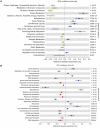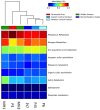Bacterioplankton Dynamics within a Large Anthropogenically Impacted Urban Estuary
- PMID: 26858690
- PMCID: PMC4726783
- DOI: 10.3389/fmicb.2015.01438
Bacterioplankton Dynamics within a Large Anthropogenically Impacted Urban Estuary
Abstract
The abundant and diverse microorganisms that inhabit aquatic systems are both determinants and indicators of aquatic health, providing essential ecosystem services such as nutrient cycling but also causing harmful blooms and disease in impacted habitats. Estuaries are among the most urbanized coastal ecosystems and as a consequence experience substantial environmental pressures, providing ideal systems to study the influence of anthropogenic inputs on microbial ecology. Here we use the highly urbanized Sydney Harbor, Australia, as a model system to investigate shifts in microbial community composition and function along natural and anthopogenic physicochemical gradients, driven by stormwater inflows, tidal flushing and the input of contaminants and both naturally and anthropogenically derived nutrients. Using a combination of amplicon sequencing of the 16S rRNA gene and shotgun metagenomics, we observed strong patterns in microbial biogeography across the estuary during two periods: one of high and another of low rainfall. These patterns were driven by shifts in nutrient concentration and dissolved oxygen leading to a partitioning of microbial community composition in different areas of the harbor with different nutrient regimes. Patterns in bacterial composition were related to shifts in the abundance of Rhodobacteraceae, Flavobacteriaceae, Microbacteriaceae, Halomonadaceae, Acidomicrobiales, and Synechococcus, coupled to an enrichment of total microbial metabolic pathways including phosphorus and nitrogen metabolism, sulfate reduction, virulence, and the degradation of hydrocarbons. Additionally, community beta-diversity was partitioned between the two sampling periods. This potentially reflected the influence of shifting allochtonous nutrient inputs on microbial communities and highlighted the temporally dynamic nature of the system. Combined, our results provide insights into the simultaneous influence of natural and anthropogenic drivers on the structure and function of microbial communities within a highly urbanized aquatic ecosystem.
Keywords: anthropogenic impacts; environmental microbiology; environmental pollutants; estuarine ecology; eutrophication; metagenomics; microbial ecology; microbiome.
Figures









Similar articles
-
Microbial ecology of northern Gulf of Mexico estuarine waters.mSystems. 2024 Aug 20;9(8):e0131823. doi: 10.1128/msystems.01318-23. Epub 2024 Jul 9. mSystems. 2024. PMID: 38980056 Free PMC article.
-
Distribution, Community Composition, and Potential Metabolic Activity of Bacterioplankton in an Urbanized Mediterranean Sea Coastal Zone.Appl Environ Microbiol. 2017 Aug 17;83(17):e00494-17. doi: 10.1128/AEM.00494-17. Print 2017 Sep 1. Appl Environ Microbiol. 2017. PMID: 28667110 Free PMC article.
-
Tracking the impacts of nutrient inputs on estuary ecosystem function.Sci Total Environ. 2022 Mar 10;811:152405. doi: 10.1016/j.scitotenv.2021.152405. Epub 2021 Dec 16. Sci Total Environ. 2022. PMID: 34923003
-
Taxon-Driven Functional Shifts Associated with Storm Flow in an Urban Stream Microbial Community.mSphere. 2018 Jul 5;3(4):e00194-18. doi: 10.1128/mSphere.00194-18. mSphere. 2018. PMID: 29976643 Free PMC article.
-
Practical considerations for sampling and data analysis in contemporary metagenomics-based environmental studies.J Microbiol Methods. 2018 Nov;154:14-18. doi: 10.1016/j.mimet.2018.09.020. Epub 2018 Oct 1. J Microbiol Methods. 2018. PMID: 30287354 Review.
Cited by
-
Composition and Functional Characteristics and Influencing Factors of Bacterioplankton Community in the Huangshui River, China.Microorganisms. 2021 Oct 29;9(11):2260. doi: 10.3390/microorganisms9112260. Microorganisms. 2021. PMID: 34835386 Free PMC article.
-
Spatial Variation in Bacterioplankton Communities in the Pearl River, South China: Impacts of Land Use and Physicochemical Factors.Microorganisms. 2020 May 29;8(6):814. doi: 10.3390/microorganisms8060814. Microorganisms. 2020. PMID: 32485891 Free PMC article.
-
Coupling between bacterial phylogenetic diversity and heterotrophic productivity in a coastal ecosystem affected by estuarine plumes.ISME Commun. 2025 Jun 20;5(1):ycaf102. doi: 10.1093/ismeco/ycaf102. eCollection 2025 Jan. ISME Commun. 2025. PMID: 40687767 Free PMC article.
-
Effect of Water Chemistry, Land Use Patterns, and Geographic Distances on the Spatial Distribution of Bacterioplankton Communities in an Anthropogenically Disturbed Riverine Ecosystem.Front Microbiol. 2021 May 6;12:633993. doi: 10.3389/fmicb.2021.633993. eCollection 2021. Front Microbiol. 2021. PMID: 34025599 Free PMC article.
-
Diversity and spatiotemporal variations in bacterial and archaeal communities within Kuwaiti territorial waters of the Northwest Arabian Gulf.PLoS One. 2023 Nov 16;18(11):e0291167. doi: 10.1371/journal.pone.0291167. eCollection 2023. PLoS One. 2023. PMID: 37972047 Free PMC article.
References
-
- Abell G. C. J., Ross D. J., Keane J. P., Oakes J. M., Eyre B. D., Robert S. S., et al. (2013). Nitrifying and denitrifying microbial communities and their relationship to nutrient fluxes and sediment geochemistry in the Derwent Estuary, Tasmania. Aquat. Microb. Ecol. 70, 63–75. 10.3354/ame01642 - DOI
-
- Anderson D. M., Glibert P. M., Burkholder J. M. (2002). Harmful algal blooms and eutrophication: nutrient sources, composition, and consequences. Estuaries 25, 704–726. 10.1007/BF02804901 - DOI
-
- Anderson M., Gorley R., Clarke K. (2008). Permanova+ For Primer: A Guide to Software and Statistical Methods. Plymouth: Primer-e.
LinkOut - more resources
Full Text Sources
Other Literature Sources

